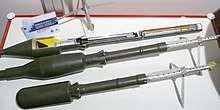RPG-7
The RPG-7 (Russian: РПГ-7, Ручной Противотанковый Гранатомёт – Ruchnoy Protivotankoviy Granatomyot) is a portable, reusable, unguided, shoulder-launched, anti-tank rocket-propelled grenade launcher. It—along with its predecessor, the RPG-2—were designed by the Soviet Union; it is now manufactured by the Russian company Bazalt. The weapon has the GRAU index (Russian armed forces index) 6G3.
| RPG-7 | |
|---|---|
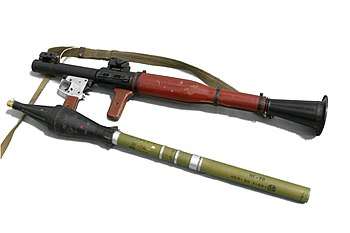 An RPG-7 launcher (top) with a Bulgarian PG-7G inert training warhead and booster (bottom) | |
| Type | Rocket-propelled grenade launcher[1] |
| Place of origin | Soviet Union |
| Service history | |
| In service | 1961–present |
| Used by | See Users |
| Wars | Since the Vietnam War |
| Production history | |
| Designer | Bazalt |
| Designed | 1958 |
| Manufacturer | Bazalt and Degtyarev plant (Russian Federation) |
| Produced | 1958–present |
| No. built | 9,000,000+ |
| Variants | RPG-7V2 (current model) RPG-7D3 (paratrooper) Type 69 RPG (China) RPG-7USA (Airtronic)[2] |
| Specifications | |
| Mass | 6.3 kg (14 lb) (without a telescopic sight) 7 kg (15 lb) (with PGO-7) |
| Length | 950 mm (37.4 in) |
| Cartridge | 85mm |
| Caliber | 40 mm |
| Muzzle velocity | 115 m/s (boost) 300 m/s (flight) |
| Effective firing range | 330 (PG-7V) |
| Maximum firing range | 700 m (OG-7V) (self detonates at ≈920 m (1,000 yd)) |
| Sights | PGO-7 (2.7×), UP-7V Telescopic sight and 1PN51/1PN58 night vision sights Red dot reflex sight |
The ruggedness, simplicity, low cost, and effectiveness of the RPG-7 has made it the most widely used anti-armor weapon in the world. Currently around 40 countries use the weapon, and it is manufactured in several variants by nine countries. It is popular with irregular and guerrilla forces. The RPG has been used in almost all conflicts across all continents since the mid-1960s from the Vietnam War to the ongoing Syrian Civil War.
Widely produced, the most commonly seen major variations are the RPG-7D (десантник - desantnik - paratrooper) model, which can be broken into two parts for easier carrying; and the lighter Chinese Type 69 RPG. DIO of Iran manufactures RPG-7s with olive green handguards, H&K pistol grips, and a Commando variant.
The RPG-7 was first delivered to the Soviet Army in 1961 and deployed at squad level. It replaced the RPG-2, having clearly out-performed the intermediate RPG-4 design during testing. The current model produced by the Russian Federation is the RPG-7V2, capable of firing standard and dual high explosive anti-tank (HEAT) rounds, high explosive/fragmentation, and thermobaric warheads (see below), with a UP-7V sighting device fitted (used in tandem with the standard 2.7× PGO-7 optical sight) to allow the use of extended range ammunition. The RPG-7D3 is the equivalent paratrooper model. Both the RPG-7V2 and RPG-7D3 were adopted by the Russian Ground Forces in 2001.
Description
The launcher is reloadable and based around a steel tube, 40 millimetres in diameter, 95.3 centimetres long, and weighing 7 kilograms. The middle of the tube is wood wrapped to protect the user from heat and the end is flared to assist in blast shielding and recoil reduction. Sighting is usually optical with a back-up iron sight, and passive infra-red and night sights are also available. The launchers designated RPG-7N1 and RPG-7DN1 can thus mount the multi-purpose night vision scope 1PN51[3] and the launchers designated RPG-7N2 and RPG-7DN2 can mount the multi-purpose night vision scope 1PN58.[4]
As with similar weapons, the grenade protrudes from the launch tubes. It is 40–105 millimetres in diameter and weighs between 2.0[5][6][7] and 4.5 kilograms. It is launched by a gunpowder booster charge, giving it an initial speed of 115 metres per second, and creating a cloud of light grey-blue smoke that can give away the position of the shooter.[8] The rocket motor[9] ignites after 10 metres and sustains flight out to 500 metres at a maximum velocity of 295 metres per second. The grenade is stabilized by two sets of fins that deploy in-flight: one large set on the stabilizer pipe to maintain direction and a smaller rear set to induce rotation. The grenade can fly up to 1,100 metres; the fuze sets the maximum range, usually 920 metres.[10]
Propulsion system
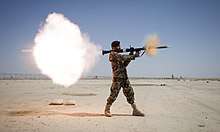
According to the United States Army Training and Doctrine Command (TRADOC) Bulletin 3u (1977) Soviet RPG-7 Antitank Grenade Launcher—Capabilities and Countermeasures, the RPG-7 munition has two sections: a "booster" section and a "warhead and sustainer motor" section. These must be assembled into the ready-to-use grenade. The booster consists of a "small strip powder charge" that serves to propel the grenade out of the launcher; the sustainer motor then ignites and propels the grenade for the next few seconds, giving it a top speed of 294 metres per second (660 mph). The TRADOC bulletin provides anecdotal commentary that the RPG-7 has been fired from within buildings, which agrees with the two-stage design. It is stated that only a 2-metre standoff to a rear obstruction is needed for use inside rooms or fortifications. The fins not only provide drag stabilization, but are designed to impart a slow rotation to the grenade.
Due to the configuration of the RPG-7 sustainer/warhead section, it responds counter-intuitively to crosswinds. A crosswind will tend to exert pressure on the stabilizing fins, causing the projectile to turn into the wind (see Weathervane effect). While the rocket motor is still burning, this will cause the flight path to curve into the wind. The TRADOC bulletin explains aiming difficulties for more distant moving targets in crosswinds at some length. Similar to a recoilless rifle the RPG-7 has no noticeable recoil, the only effect during firing being that of the sudden lightness of the launcher as the rocket leaves the tube.
Airtronic RPG-7
In 2009, the American company Airtronic USA unveiled a modernized version of the weapon called the RPG-7USA. The launcher is fitted with updated features including a MIL-STD-1913 Quad Rail System for mounting combat optics, flip-up back up iron sights, aiming lasers/illuminators, tactical lights, and vertical foregips, as well as an M4 carbine-style pistol grip and telescoping stock. Compared to the RPG-7V2, the American launcher, named by the company the Precision Shoulder-fired Rocket Launcher (PSRL-1), is slightly lighter at 14 lb (6.35 kg) unloaded without optics and is made of 4140/4150 ordnance-grade steel for a longer 1,000-round lifespan that can separate into two pieces for compact carry. The PSRL-1 uses EOTech sights with a new sighting system that combines an illuminated reticule for use in low light situations, and is able to be fitted with magnifying optical sights for long-range firing enabling 90% hit probability at 800 metres, twice the distance of other RPGs; rate of fire is 3-4 rounds per minute. It is reportedly accurate at ranges from 900-1,200 m, and guided rockets could extend range to 2 000 metres. The weapon was a program of record in U.S. Special Operations Command by 2015, and the PSRL-1 was to enter production by mid-2016. Airtronic has also developed the more advanced GS-777/PSRL-2 model made of high-strength polymer that reduces weight to 7.77 lb (3.5 kg) and further improves durability and life cycle.[11][12][13][14][15]
Ammunition

I) The head contains
- trigger
- conductive cone
- aerodynamic fairing
- conical liner
- body
- explosive
- conductor
- detonator
- nozzle block
- nozzle
- motor body
- propellant
- motor rear
- ignition primer
- fin
- cartridge
- charge
- turbine
- tracer
- foam wad
The RPG-7 can fire a variety of warheads for anti-armor (HEAT, PG-Protivotankovaya Granata) or anti-personnel (HE, OG-Oskolochnaya Granata) purposes, usually fitting with an impact (PIBD) and a 4.5 second fuze. Armor penetration is warhead dependent and ranges from 30 to 60 centimetres of RHA; one warhead, the PG-7VR, is a 'tandem charge' device, used to defeat reactive armor with a single shot.
Current production ammunition for the RPG-7V2 consists of four main types:
- PG-7VL [c.1977] Improved 93 mm HEAT warhead effective against most vehicles and fortified targets.[5][6][7]
- PG-7VR [c.1988] Dual 64 mm/105 mm HEAT warhead for defeating modern armored vehicles equipped with reactive armor blocks. The first warhead (64 mm HEAT) detonates the reactive armor block prematurely and the second warhead (105 mm HEAT) passes through the gap to hit the exposed armor underneath.
- TBG-7V Tanin [c.1988] 105 mm Thermobaric warhead for anti-personnel and urban warfare.
- OG-7V [c.1999] 40 mm Fragmentation warhead for anti-personnel warfare. Has no sustainer motor.
Other warhead variants include:
- PG-7V [c.1961] Baseline 85 mm HEAT warhead capable of penetrating 260 mm RHA.[16][17][18]
- PG-7VM [c.1969] Improved 70 mm HEAT warhead capable of penetrating 300 mm RHA.[17][18]
- PG-7VS [c.1972] Improved 73 mm HEAT warhead capable of penetrating 400 mm RHA.[17][18]
- PG-7VS1 [c.mid-1970s] Cheaper PG-7VS version capable of penetrating 360 mm RHA.[17]
- GSh-7VT [c.2013] Anti-bunker warhead with cylindrical follow-through blast-fragmentation munition followed by explosively formed penetrator.[19]
Specifications
Manufacturer specifications for the RPG-7V1.[20][21]
| Name | Type | Image | Weight | Explosive weight[22][23][24] | Diameter | Penetration | Lethal radius |
|---|---|---|---|---|---|---|---|
| PG-7VL | Single-stage HEAT | 2.6 kg (5.7 lb) | 730 g OKFOL (95% HMX + 5% wax) | 93 mm (3.7 in) | >500 mm (20 in) RHA | ||
| PG-7VR | Tandem charge HEAT | 4.5 kg (9.9 lb) | ?/1.43 kg OKFOL (95% HMX + 5% wax) | 64 mm (2.5 in)/105 mm (4.1 in) | 600 mm RHA (with reactive armor) 750 mm RHA[25] (without reactive armor) |
||
| OG-7V | Fragmentation | 2 kg (4 lb) | 210 g (7.4 oz) A-IX-1 | 40 mm (1.6 in) | 7 m (23 ft) (vs. body armor)[26][27] | ||
| TBG-7V | Thermobaric | 4.5 kg (9.9 lb) | 1.9 kg ОМ 100МИ-3Л + 0.25 kg A-IX-1(as thermobaric explosive booster) | 105 mm (4.1 in) | 10 m (30 ft) | ||
Airtronic ammunition
Airtronic Shoulder-Fired Rocket Ammunition are developed by AirTronic as a modernized RPG-7 rocket type of shoulder-fired ammunition. All ammunition is manufactured in the United States and the Intellectual Property is fully owned by AirTronic USA. AirTronic shoulder-fired rocket ammunition is recommended for use in AirTronic rocket launchers such as the PSRL and GS-777 in order to achieve the highest level of performance. The legacy external configuration of the RPG rocket has been maintained such that AirTronic ammunition is backwards compatible with existing RPG-7 type launchers.
While the external configuration of the legacy RPG rocket has been maintained, improvements have been made focusing on the fuzing, reliability, robustness, and manufacturing quality per DoD standards. The warhead fuze features a dual safe and arm arrangement for improved handling safety. Also, the rocket motor ignitor fuze has been redesigned to improve motor ignition reliability.
Inert training variants are also available which match the ballistics of the live ammunition. This allows for safe training at a reduced cost. Training variants inert warheads are filled with marking compound so that the impact of the round can be observed.
The 3 variants are:
- SR-H1 is suitable for PSRLs + RPG-7s. It is a 3.82kg 93mm HEAT warhead that is able to penetrate 500m RHA. Its effective range is at 500m, while maximum range can reach up to 800m. The fire rate is between 4 to 6 rpm.
- SR-T1 is suitable for PSRLs + RPG-7s. It is a 3.82kg 93mm Inert warhead that can't penetrate armor because its for training only. Its effective range is at 500m, while maximum range can reach up to 800m. The fire rate is between 4 to 6 rpm.
- SR-T2 is suitable for PSRLs + RPG-7s. It is a 2.12kg 70mm Inert warhead that can't penetrate armor because its for training only. Its effective range is at 800m, while maximum range can reach up to 1200m. The fire rate is between 4 to 6 rpm.
Hit probabilities
A 1976 U.S. Army evaluation of the weapon gave the hit probabilities on a 5-metre (16 ft) wide, 2.5-metre (8 ft 2 in) tall panel moving sideways at 4 metres per second (8.9 mph).[28] This probability decreases when firing in a crosswind due to the unusual behaviour of the round; in an 11-kilometre-per-hour (6.8 mph) (3 m/s) wind, the gunner cannot expect to get a first-round hit more than 50% of the time beyond 180 m.[29]
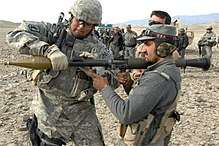
| Range | Percent |
|---|---|
| 50 m | 100% |
| 100 m | 96% |
| 200 m | 51% |
| 300 m | 22% |
| 400 m | 9% |
| 500 m | 4% |
History of use
Accurate firing is difficult at ranges over 200 metres. During the Soviet–Afghan War, the mujahideen tended to use the weapon at ranges of less than 80 metres.
The RPG-7 was used by the Provisional Irish Republican Army in Northern Ireland from 1969 to 2005, most notably in Lurgan, County Armagh, where it was used against British Army observation posts and the towering military base at Kitchen Hill in the town.[30] The IRA also used them in Catholic areas of West Belfast against British Army armoured personnel carriers and Army forward operating bases (FOB). Beechmount Avenue in Belfast became known as "RPG Avenue" after attacks on British troops.[31]
In Mogadishu, Somalia, RPG-7s were used to down two U.S. Army Black Hawk helicopters in 1993.[32][33]
Users
.jpg)
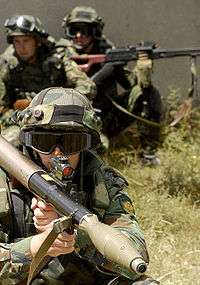
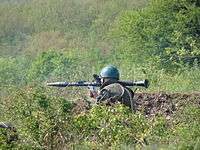
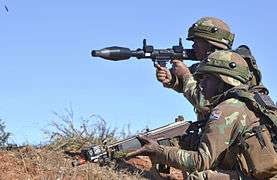



































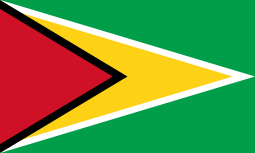



















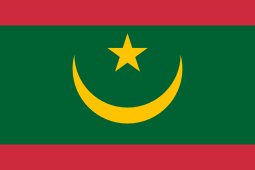




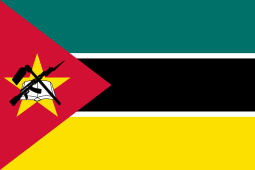








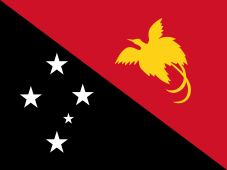
































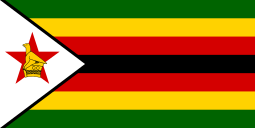
Former users

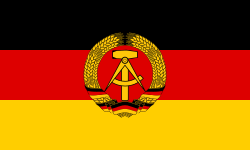

.svg.png)



.svg.png)

Non-state users
See also
- AT4
- AT-3 Sagger
- B-300
- Carl Gustav recoilless rifle
- Bazooka
- M72 LAW
- Panzerfaust 3
- RPG-16
- RPG-18
- Yasin (RPG)
- MK153
- List of Russian weaponry
References
- Rottman, Gordon L. (2010). The Rocket Propelled Grenade. Weapon 2. Osprey Publishing. ISBN 978-1-84908-153-5.CS1 maint: ref=harv (link)
- "RPG-7/RPG-7V/RPG-7VR Rocket Propelled Grenade Launcher (Multi Purpose Weapon)". Defense Update. 2006. Archived from the original on 8 June 2011. Retrieved 23 January 2011.
- Rottman 2010, p. 41.
- ИЗДЕЛИЕ 1ПН51 ТЕХНИЧЕСКОЕ ОПИСАНИЕ И ИНСТРУКЦИЯ ПО ЭКСПЛУАТАЦИИ [PRODUCT 1PN51 TECHNICAL DESCRIPTION AND OPERATING INSTRUCTIONS] (in Russian). January 1992. pp. 11, 16.
- ИЗДЕЛИЕ 1ПН58 ТЕХНИЧЕСКОЕ ОПИСАНИЕ И ИНСТРУКЦИЯ ПО ЭКСПЛУАТАЦИИ [PRODUCT 1PN58 TECHNICAL DESCRIPTION AND OPERATING INSTRUCTIONS] (in Russian). February 1991. pp. 5, 15.
- John Pike. "RPG-7". globalsecurity.org. Archived from the original on 2013-11-05. Retrieved 2014-01-20.
- "RosOboronExport". rusarm.ru. Archived from the original on 2013-10-20. Retrieved 2014-01-20.
- "Images stories of east_europe,rpg-7_ammunition_Russia_russian_001". armyrecognition.com. Archived from the original on 2013-11-06. Retrieved 2014-01-20.
- (U.S.), Infantry School; School, United States Army Infantry; Office, United States Army Infantry School Editorial and Pictorial; Dept, United States Army Infantry School Book (3 October 1998). "Infantry". U.S. Army Infantry School – via Google Books.
- no rocket motors in OG-7V
- Grillo, Ioan. "Mexico's Drug Lords Ramp Up Their Arsenals with RPGs". Archived from the original on 2013-04-06. Retrieved 2013-04-06 – via world.time.com.
- Airtronic USA Develops American RPG-7: Meet the Amerikansky Rocket-Propelled Grenade Launcher Archived 2017-09-03 at the Wayback Machine - Defensereview.com, 13 April 2009
- Everything is Cooler with Rails - Airtronic's RPG7-USA Archived 2016-09-19 at the Wayback Machine - Militarytimes.com, 21 May 2009
- U.S. Army Tests Soviet-Designed Rocket Launcher Archived 2017-10-21 at the Wayback Machine - Kitup.Military.com, 18 February 2015
- RPGs, grenades and dummies: 9 soldier-tested gadgets - Armytimes.com, 6 April 2015
- Americanized RPG-7 is Ready to Serve Archived 2017-07-17 at the Wayback Machine - Defense-Update.com, 14 October 2015
- RPG-7 antitank grenade launcher (USSR / Russia) Archived 2017-01-16 at the Wayback Machine - Modernfirearms.net
- RPG-7 Archived 2017-01-16 at the Wayback Machine - Military-Today.com
- RPG-7 Anti-tank rocket grenade launcher Archived 2017-01-16 at the Wayback Machine - Armyrecognition.com
- FKP GkNIPAS completes development of anti-bunker round for RPG-7V2 grenade launcher Archived 2013-09-22 at the Wayback Machine - Janes.com, 30 June 2013
- "Rosoboronexport". Rusarm.ru. Archived from the original on 2012-02-04. Retrieved 2012-02-20.
- John Pike. "RPG-7". Globalsecurity.org. Archived from the original on 2011-10-08. Retrieved 2012-02-20.
- Per Ordata Archived 2010-03-10 at the Wayback Machine
- Per Archived 2011-07-27 at the Wayback Machine The last picture, source from deputy chief designer of Bazalt
- Per Archived 2011-06-08 at the Wayback Machine defense-update RPG-29 due to PG-29V and PG-7VR has same warhead
- ARG. "RPG-7 Anti-Tank Rocket Launcher | Military-Today.com". www.military-today.com. Archived from the original on 2018-03-14. Retrieved 2018-03-14.
- Tilstra, Russel C. "Small Arms for Urban Combat: A Review". books.google.com.
- "OG-7V Fragmentation round". Rosoboronexport. Rosoboronexport.
- TRADOC BULLETIN 1, Range and Lethality of U.S. and Soviet Anti-Armour Weapons. United States Army Training And Doctrine Command. 30 September 1975. Archived from the original on 14 July 2014. Retrieved 6 July 2014.
- TRADOC BULLETIN 3, Soviet RPG-7 Antitank Grenade Launcher. United States Army Training And Doctrine Command. November 1976.
- Oppenheimer, A.R. (2009). IRA The Bombs and the Bullets: A history of deadly ingenuity. Dublin: Irish Academic Press. p. 227. ISBN 978-0-7165-2895-1. pp. 240–241
- Harrison, David (2007-05-13). "Fragile calm behind Ulster's 'peace walls'". Telegraph.co.uk. Archived from the original on 2012-11-13. Retrieved 2012-02-20.
- Speck, Shane (2004-03-11). "How Rocket-Propelled Grenades Work". Science.howstuffworks.com. Archived from the original on 2012-03-01. Retrieved 2012-02-20.
- Thornton, Rod (12 February 2007). "Asymmetric Warfare: Threat and Response in the 21st Century". Polity – via Google Books.
- Jones, Richard D. Jane's Infantry Weapons 2009/2010. Jane's Information Group; 35 edition (January 27, 2009). ISBN 978-0-7106-2869-5.
- Bonn International Center for Conversion. "RPG 7". SALW Guide: Global distribution and visual identification. Archived from the original on 2019-03-25. Retrieved 2018-08-28.
- Gore, Patrick Wilson (2008). 'Tis Some Poor Fellow's Skull: Post-Soviet Warfare in the Southern Caucasus. iUniverse. p. 60. Retrieved 2018-08-28.
RPG-7 karabagh.
- ATGL-L anti-tank grenade launcher Archived 2010-08-21 at the Wayback Machine, arsenal.bg
- "Burkina Faso: Un véhicule emporté lors d'un braquage à Ouahigouya". koaci.com (in French). 13 October 2016. Archived from the original on 29 August 2018. Retrieved 28 August 2018.
- Cherisey, Erwan de (July 2019). "El batallón de infantería "Badenya" de Burkina Faso en Mali - Noticias Defensa En abierto". Revista Defensa (in Spanish) (495–496).
- Rottman 2010, p. 36.
- Rottman 2010, p. 37.
- "Rosyjska broń dla Fidżi" (in Polish). altair.pl. Archived from the original on 2016-03-04. Retrieved 2016-02-21.
- "Archived copy". Archived from the original on 2014-12-22. Retrieved 2015-04-09.CS1 maint: archived copy as title (link)
- "ქართული წარმოების სამხედრო აღჭურვილობა". geo-army.ge. Archived from the original on 2014-02-01. Retrieved 2014-01-20.
- "Archived copy" (PDF). Archived from the original (PDF) on 2014-10-26. Retrieved 2014-09-17.CS1 maint: archived copy as title (link)
- Lugosi, József (2008). "Gyalogsági fegyverek 1868–2008". In Lugosi, József; Markó, György (eds.). Hazánk dicsőségére: 160 éves a Magyar Honvédség. Budapest: Zrínyi Kiadó. p. 389. ISBN 978-963-327-461-3.
- Rottman 2010, p. 38.
- Rottman 2010, p. 33.
- Katz, Samuel (1986) Israeli Defence Forces Since 1973. Osprey ISBN 0-85045-687-8
- Berman, Eric G. (March 2019). Beyond Blue Helmets: Promoting Weapons and Ammunition Management in Non-UN Peace Operations (PDF). Small Arms Survey/MPOME. p. 43.
- Rottman 2010, p. 43.
- Nazrini Badarun (24 May 2017). "Unit khas polis ESSZONE akan terima RPG baru" (in Malay). New Sabah Times. Archived from the original on 5 June 2017. Retrieved 6 June 2017.
- "Rocket-propelled grenade boost for security". Daily Express. 24 May 2017. Archived from the original on 5 June 2017. Retrieved 6 June 2017.
- Touchard, Laurent (18 June 2013). "Armée malienne : le difficile inventaire". Jeune Afrique. Archived from the original on 29 August 2018. Retrieved 28 August 2018.
- Vines, Alex (March 1998). "Disarmament in Mozambique". Journal of Southern African Studies. 24 (1): 191–205. JSTOR 2637453.
- https://read01.com/O3LKK6j.html#.W2hV8Lh9iUk
- Okoroafor, Cynthia (2015-08-27). "You probably didn't know that Nigeria already manufactures these weapons". Ventures. Archived from the original on 2017-02-02. Retrieved 2017-01-24.
- "Bundeswehr in Niger: Unterwegs mit einer Patrouille". www.bmvg.de. Archived from the original on 2017-08-08. Retrieved 2017-08-08.
- "IDEAS 2012". 6 (3). Small Arms Defense Journal. 5 December 2014. Archived from the original on 2 June 2017. Retrieved 10 December 2014. Cite journal requires
|journal=(help) - "IDEAS 2016—Pakistan". 9 (4). Small Arms Defense Journal. 13 October 2017. Archived from the original on 23 October 2017. Retrieved 22 October 2017. Cite journal requires
|journal=(help) - Alpers, Philip (2010). Karp, Aaron (ed.). The Politics of Destroying Surplus Small Arms: Inconspicuous Disarmament. Abingdon-on-Thames: Routledge Books. pp. 168–169. ISBN 978-0-415-49461-8.
- "Philippines acquires RPG-7 (USA) for anti-armour operations". 2014-01-13. Archived from the original on January 16, 2014. Retrieved 2014-01-15.
- "Russia and Philippines sign military-technical agreement : Ministry of Defence of the Russian Federation". eng.mil.ru. Archived from the original on 2017-10-29. Retrieved 2017-10-29.
- http://www.armstrade.org/includes/periodics/news/2019/0725/103053577/detail.shtml
- Rottman 2010, p. 39.
- Carfil website Archived August 27, 2007, at the Wayback Machine
- Ignacio Fuente Cobo; Fernando M. Mariño Menéndez (2006). El conflicto del Sahara occidental (PDF) (in Spanish). Ministerio de Defensa de España & Universidad Carlos III de Madrid. p. 78. ISBN 84-9781-253-0.
- https://web.archive.org/web/20181101183111/http://www.ppt-namenska.rs/en/rbr7.html
- "Anti Tank weapons". South African Army. Archived from the original on 2013-07-05. Retrieved 2014-01-20.
- Small Arms Survey (2014). "Weapons tracing in Sudan and South Sudan" (PDF). Small Arms Survey 2014: Women and guns (PDF). Cambridge University Press. pp. 227, 229, 234. Archived (PDF) from the original on 2016-10-14. Retrieved 2018-08-28.
- Sinar Light Antitank Rocket Launcher Archived 2009-04-01 at the Wayback Machine Retrieved on March 17, 2009.
- Pike, John (2004-05-14). "The future of Russian-Turkish military-technical cooperation". Globalsecurity.org. Archived from the original on 2015-09-24. Retrieved 2012-02-20.
- Rottman 2010, p. 19.
- Russell, Lee E. (28 Mar 1985). Grenada 1983. Men-at-Arms 159. Osprey Publishing. p. 44. ISBN 9780850455830.
- Grant, Neil (2015). Rhodesian Light Infantryman: 1961-1980. Warrior 177. Osprey Publishing. p. 23. ISBN 9781472809629.
- Nortje, Piet (2003). 32 Battalion. Zebra Press. p. 98. ISBN 978-1-86872-914-2.
External links
| Wikimedia Commons has media related to RPG-7. |
